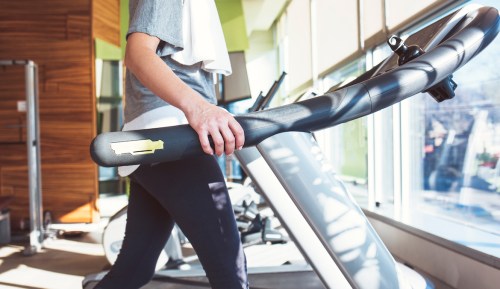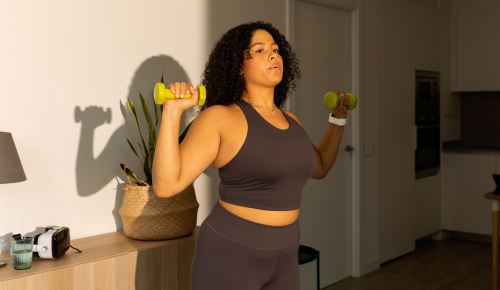Ah yes: the fitness plateau. By this point, you’ve probably heard about that dreaded landscape where fitness goals roll by you like a rambling tumbleweed.
Experts in This Article
yoga instructor, founder and CEO of Y7 Studio
strength and running instructor at Peloton
fitness manager at Equinox Group
Listen, it can be easy to fall into a slump. Sometimes just getting to a workout is a victory. But, if you’ve got a fitness goal in mind—or simply enjoy seeing what your body is capable of (seriously, how cool?!)—it’s crucial to switch up your workouts to continue seeing progress.
“Different types of workouts target different types of muscles and focus on different things,” says yoga instructor Sarah Larson Levey, founder and CEO of Y7 Studio. “Changing it up allows your body to experience multiple types of challenges and muscle engagement. It also helps you avoid overtraining certain body parts or muscle groups. It’s also important to remember that changing up your routine is helpful for hitting your fitness goals.”
In fact, progressing your workouts is a key facet of periodization, a common approach to structuring workouts and training plans for growth, adaptation, recovery, and ultimately, heightened performance, according to the National Strength and Conditioning Association (NSCA).
Ahead, more on the benefits of switching things up, how to do so safely, and when to take your foot off the gas.
Why do you need to change up your fitness routine?
Let’s get this out of the way: you don’t, necessarily. If you’re simply focused on moving your body in a way that feels good without a ton of structure, amazing, we love that for you. Stick with that.
But, if you’ve finally signed up for a half marathon, recently got bit by the powerlifting bug, or are low-key just inspired by the athletes you see on TV (same), switching up your fitness routine is a fundamental component for upping your game, whatever it is.
“When you perform the same moves over and over again your muscles adapt to the movements, and you can plateau because your muscles become so efficient at that move that they no longer need to work hard to do them,” explains Peloton instructor Selena Samuela, CPT.
Without a new stimulus, your body—and brain—don’t require as much energy to perform the movement. With a new stress, like a heavier weight, your mind and body have to respond, per the University of Portsmouth. This is where the magic (okay, science) happens. Your central nervous system is called upon to light up, releasing more hormones into the body to react. Then, microtears in the muscle occur, followed by some saucy adaptations1, including strength, power, and/or endurance. New fitness level unlocked.
This is all summed up in the “SAID Principle,” according to the American Council on Exercise. SAID, or specific adaptations to imposed demands, means our bodies will—you guessed it—adapt to new weights, intensities, volumes, and/or length of exercise.
Beyond dodging that sassy plateau, switching up your workouts can also help curtail potential overuse injuries, while addressing any muscular imbalances, which can contribute to these setbacks. Changing up your workout routine can help avoid “overuse of the same muscle group, and [the same] exercise pattern can often lead to injury,” says Waz Ashayer, CPT, fitness manager at Equinox Group.
Especially common among endurance athletes2, overuse injuries can occur from repeating the same movements, scaling intensity or load too quickly, or inadequate recovery time, among other reasons. According to a wide review in the journal Sports Medicine3, overuse injuries “most frequently result from overload or repetitive microtrauma stemming from extrinsic factors such as training errors, poor performance, poor techniques and inappropriate surfaces, or intrinsic factors including malalignment and muscle imbalance.”
This is where those clamshells come in handy (IYKYK). By progressing and introducing new moves, your body can become more effective at the exercise. For example, runners with weak glutes might rely on their calves to propel forward, causing unnecessary strain on the muscle, resulting in injuries like tendonitis or stress reactions4. By strengthening smaller glute muscles, like the glute medius (which clamshells target), your running gait can perform the primary movement more effectively, lowering the strain on the calf and therefore, potentially reducing injury risk.
But that’s if you’re still showing up to training sessions. Real quick: How often is everyone bored at the gym? If you find yourself running through your to-do list while at the squat rack, strategically upping your load can help to refocus. Switching up your workout routine can help stay more engaged without losing motivation, Ashayer confirms. There’s nothing more convincing than crushing a workout to stick to a training plan, right?
What are the benefits to switching up your workout routine?
As discussed, mixing up your workouts can offer a slew of perks. From upping your fitness performance and helping to avoid overuse injuries, switching your workout routine is fundamental if you’ve got your sights on optimizing your fitness performance, staying healthy, and locking into your training sessions.
“Conditioning-wise, [mixing up your workouts] is a great tool as you can explore and target sessions for both aerobic and anaerobic cardio systems. This will make a huge impact on your overall fitness and health,” Ashayer says.
By strengthening your aerobic (endurance) and anaerobic5 (power) systems, sports conditioning can be enhanced. Prepare to be the all-star of your rec soccer team.
“When you perform the same moves over and over again your muscles adapt to the movements, and you can plateau because your muscles become so efficient at that move that they no longer need to work hard to do them.” —Selena Samuela, CPT
How often should you change your workout routine?
This can vary greatly from person to person. If you’re looking for individualized guidance, consider working with a licensed personal trainer, physical therapist, or other certified expert for hands-on support.
Indeed, all three experts explained that your goals, current fitness level, injury history, and time availability can all influence how often you should switch things up.
“That really depends on what your goals are and what you enjoy doing,” Levey reiterates.
But, there are some general rules of thumb.
“Frequency [of switching things up] depends on your goals and the type of exercise,” Ashayer says. “Strength training typically changes exercises every four to six weeks. Cardiovascular training changes intensity or type every two to four weeks.”
Remember how we talked quickly about periodization? This is where it comes into play. With periodization, your day-to-day, week-to-week, and yes, month-to-month progress should be mapped out, making plenty of space for recovery days and weeks to allow your body to repair.
While there are several philosophies about the specific types of periodization, your fitness goals will help determine the best approach. For example, new runners should increase their weekly mileage by no more than 10 percent each week, according to Road Runners Club of America. But for strength training or powerlifting, the guidance is, perhaps, even more athlete dependent.
What can switching things up look like?
Regardless of your fitness goals, “switching it up” is best executed in a methodical and mindful approach.
“Slow and steady is the name of the game—you don’t want to shock your body and end up injuring yourself,” Levey says.
Sameula agrees, saying there’s no one-size-fits-all approach to evolving your workouts.
But when it comes down to mixing it up, most athletes have the same shake-up menu that includes changing the exercise volume, intensity or load, and length.
“You might change exercises, intensity, or focus weekly or monthly rather than daily. Consistency over time equals progress. There should be a general structure with periodic changes—this keeps workouts effective and sustainable,” Ashayer says.
For example, if you tend to stick to low-key lap swimming, what if you tried a spin class that’s a little more intense? Alternatively, if you’re a regular at the HIIT studio, when was the last time you did Pilates or a good ol’ fashioned strength- training session?
If you’re more dialed into reaching a specific goal, like a race or competition, working with a coach can help to structure your workouts with tweaks to your daily and weekly sessions that emphasize your needs for game day, Ashayer says.
Another area to consider experimenting within? Recovery. Without regular maintenance, fueling, and rest, your body is more vulnerable to an injury or overtraining syndrome: a condition that involves lower fitness performance, missing your period, and overuse injuries.
For example, if you’ve got your sleep down, consider what an active recovery day might look like—perhaps yoga or a gentle stretching class. When was the last time you treated yourself to a sports massage or acupuncture? Meanwhile, if you’re a maven in the kitchen, you might consider whipping up some nourishing meals. Curious athletes can be the most successful, as searching for what works for you can be an ongoing investigation that might score major rewards.
What happens if you don’t ever change your workout routine?
Welcome to life on the plateau, where workouts can become mediocre and your focus is…wait, what were we saying?
“You run the risk of overuse injury—that’s the scariest— you could plateau, or you could get bored and stop doing the workouts entirely,” Samuela says.
Ashayer agrees.
“Diminishing returns [happen if you don’t mix up your workouts]. This simply means the more experienced you are at something the less you progress with that particular stimulus,” he says.
Is there anyone who shouldn’t mix up their workouts?
Definitely. If you’re recovering from an injury where movement might harm your healing progress or managing a health condition that might worsen with certain types of exercise, be sure to check in with a licensed medical provider before advancing your workouts.
These aren’t necessarily dealbreakers, but it’s key to work with a professional familiar with your specific needs to come up with a plan that will work for you.
Bernárdez-Vázquez R, Raya-González J, Castillo D, Beato M. Resistance Training Variables for Optimization of Muscle Hypertrophy: An Umbrella Review. Front Sports Act Living. 2022 Jul 4;4:949021. doi: 10.3389/fspor.2022.949021. PMID: 35873210; PMCID: PMC9302196.
↩︎Yang J, Tibbetts AS, Covassin T, Cheng G, Nayar S, Heiden E. Epidemiology of overuse and acute injuries among competitive collegiate athletes. J Athl Train. 2012 Mar-Apr;47(2):198-204. doi: 10.4085/1062-6050-47.2.198. PMID: 22488286; PMCID: PMC3418132.
↩︎Yang J, Tibbetts AS, Covassin T, Cheng G, Nayar S, Heiden E. Epidemiology of overuse and acute injuries among competitive collegiate athletes. J Athl Train. 2012 Mar-Apr;47(2):198-204. doi: 10.4085/1062-6050-47.2.198. PMID: 22488286; PMCID: PMC3418132.
↩︎Kahanov L, Eberman LE, Games KE, Wasik M. Diagnosis, treatment, and rehabilitation of stress fractures in the lower extremity in runners. Open Access J Sports Med. 2015 Mar 27;6:87-95. doi: 10.2147/OAJSM.S39512. PMID: 25848327; PMCID: PMC4384749.
↩︎Gastin PB. Energy system interaction and relative contribution during maximal exercise. Sports Med. 2001;31(10):725-41. doi: 10.2165/00007256-200131100-00003. PMID: 11547894.
↩︎
Sign Up for Our Daily Newsletter
Get all the latest in wellness, trends, food, fitness, beauty, and more delivered right to your inbox.
Got it, you've been added to our email list.











